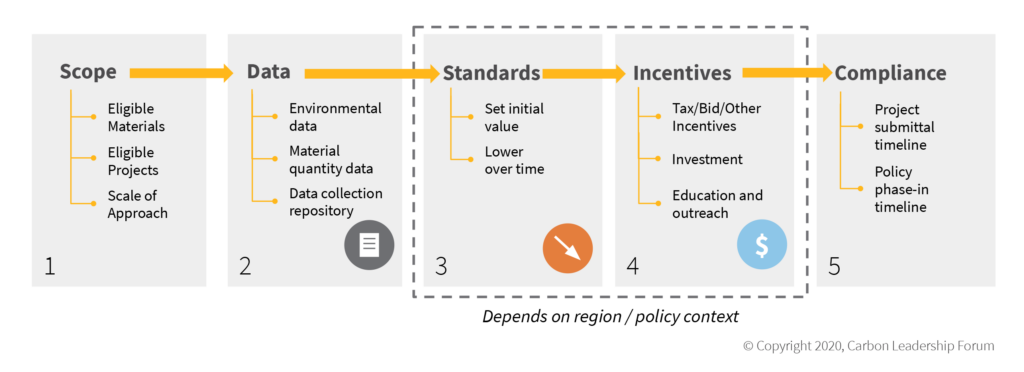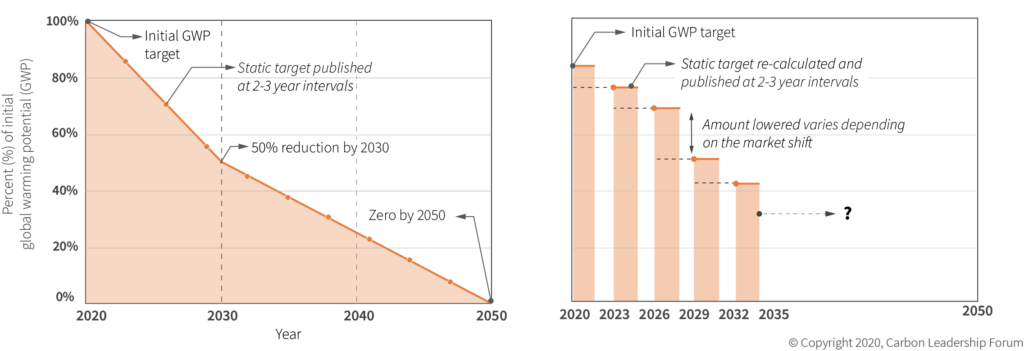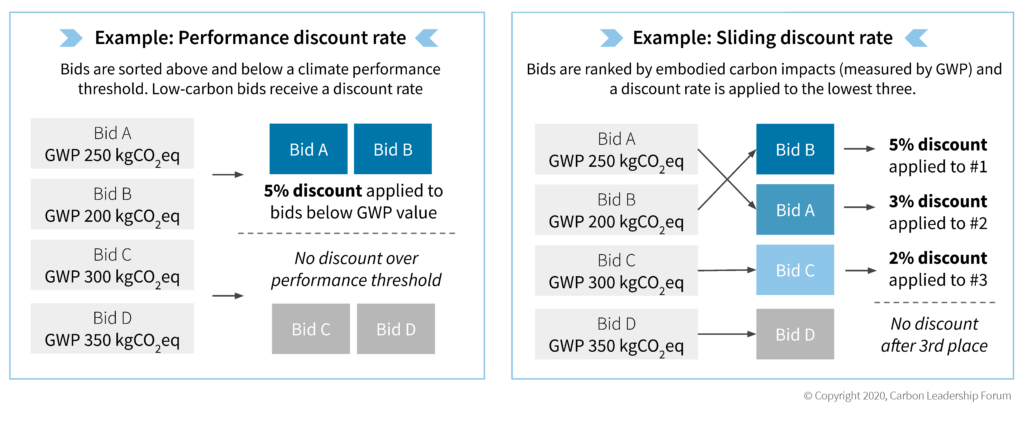Cette ressource donne un aperçu des cinq composants de base de Buy Clean et met en évidence les choix clés à chaque étape.
Version: 17 décembre 2020
Composants clés de Buy Clean
Une politique d'achat de carbone incorporée, également appelée politique `` Buy Clean '' après l'adoption du projet de loi californien en 2017, est composée de trois à cinq éléments essentiels qui répondent aux questions suivantes:
- Portée: Quels matériaux et projets sont impactés par la politique? Sous quelle agence gouvernementale?
- Les données: Quels types de données environnementales et de projet doivent être soumis pour se conformer à la politique?
- Normes [facultatif]: Les matériaux ou projets doivent-ils être inférieurs à un potentiel de réchauffement planétaire (PRG)?
- Incitations [facultatif]: Existe-t-il un soutien financier et éducatif pour les fabricants et / ou les entreprises qui se conforment à la politique?
- Conformité: Quel est le calendrier de soumission et de mise en œuvre de chaque composante de la politique?
Pour en savoir plus sur chacune des étapes, consultez la Figure 1 et suivez le guide en cinq étapes fourni dans ce guide.
La législation Buy Clean varie considérablement en fonction de son contexte géographique et politique. Géographiquement, l'empreinte carbone des matériaux et la disponibilité des données de divulgation du carbone incorporé varient largement en raison principalement de l'intensité en carbone de l'énergie disponible dans la région (pour les produits locaux); et la quantité de déclarations environnementales de produits (EPD) disponible dans la région pour définir potentiel de réchauffement climatique (GWP) normes. Les objectifs de PRG sont mesurés en kilogrammes d'équivalents de dioxyde de carbone (kg CO2eq) par unité fonctionnelle de produit. Voir Carbone incorporé 101 pour des conseils supplémentaires.
City, state, and federal agencies can all implement Buy Clean type procurement policies, but they all have different project types, purchasing power, incentive levers, and environmental data availability that will influence the scope of policy. A federal Buy Clean program may have more funding available to incentivize research, whereas a state Buy Clean program may be able to set regionally appropriate GWP targets earlier.
Pour plus d'informations, voir le guide Qu'est-ce que la politique d'achat propre? et / ou l'évaluation complète de la politique dans le 2019 Acheter une étude Clean Washington.

Figure 1. Présentation de cinq composants clés de Buy Clean.
Étape 1 - Établir la portée de la politique
1.1
Matériaux éligibles
Quels matériaux seront couverts par la police? (sélectionnez un sous-ensemble de matériaux de construction ciblant un segment spécifique de l'industrie, tel que :)
❒ 1. Principaux matériaux de structure, y compris le béton, l'acier et le bois
❒ 2. Matériaux et finitions architecturales potentiellement à fort impact, y compris l'aluminium, le verre, l'isolation, les carreaux de plafond, les plaques de plâtre et les revêtements de sol
❒ 3. Matériaux civils, y compris les chaussées en asphalte, le béton et l'acier
❒ 4. Matériaux exposés au commerce à fort impact
 Considérations supplémentaires: descriptions des matériaux
Considérations supplémentaires: descriptions des matériaux 
La terminologie de dénomination des matériaux doit être alignée sur la terminologie de l'industrie pour communiquer clairement la portée aux entrepreneurs, ingénieurs, architectes et fabricants. Les décideurs peuvent garantir une communication claire du champ d'application en:
- Engager la communauté AEC locale à examiner les descriptions matérielles pour plus de clarté
- Adopter la terminologie de dénomination dans le calculateur de carbone incorporé dans la construction (EC3) qui a été développé en collaboration avec des associations professionnelles pour chaque matériau
1.2
Projets éligibles
Quels types de projets seront couverts par la politique? (sélectionner une option)
❒ 1. Tous les projets de construction, y compris les bâtiments et le transport *
❒ 2. Certains projets, tel que défini par un seuil de superficie (c'est-à-dire «projets de plus de 20 000 pieds carrés») ou un seuil budgétaire (c'est-à-dire «projets avec un budget supérieur à un million USD»)
* Remarque: la législation Buy Clean doit identifier les agences gouvernementales ayant des projets éligibles. Ces agences varient selon la région, mais des exemples d'agences clés comprennent les départements des transports et les universités d'État.
 Considérations supplémentaires: taille du projet
Considérations supplémentaires: taille du projet 
Exiger tous les projets de construction garantit l'impact le plus large. Cependant, la taille du projet est généralement liée à la taille de l'entreprise travaillant sur le projet. La fixation d'un seuil de superficie ou de budget peut aider à réduire la probabilité que les petites entreprises sans ressources à consacrer à la formation liée à l'approvisionnement à faible émission de carbone soient désavantagées.
1.3
Échelle d'approche
La politique sera-t-elle centrée uniquement sur les matériaux (à l'échelle des matériaux) ou tiendra-t-elle compte de l'impact environnemental global du projet (à l'échelle du bâtiment) en plus des matériaux?
❒ 1. Échelle des matériaux
❒ 2. Échelle des matériaux et des bâtiments
 Considérations supplémentaires: échelle
Considérations supplémentaires: échelle 
Les politiques à l'échelle matérielle sont moins complexes et donc plus faciles à mettre en œuvre que les politiques à l'échelle du bâtiment. Ils se concentrent sur la transition vers une fabrication propre. Les politiques à l'échelle du bâtiment sont plus complexes, mais promeuvent des stratégies de réduction du carbone plus larges qui peuvent entraîner des réductions de carbone plus importantes, telles que l'efficacité des matériaux et la réutilisation des bâtiments ou des matériaux.


